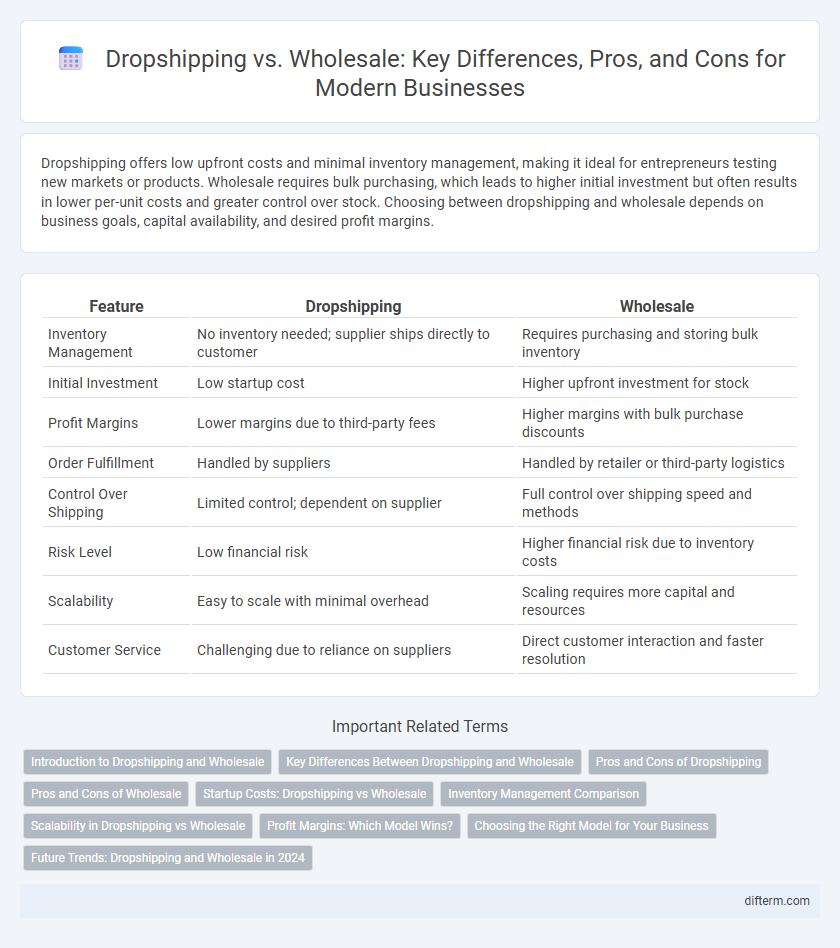Dropshipping offers low upfront costs and minimal inventory management, making it ideal for entrepreneurs testing new markets or products. Wholesale requires bulk purchasing, which leads to higher initial investment but often results in lower per-unit costs and greater control over stock. Choosing between dropshipping and wholesale depends on business goals, capital availability, and desired profit margins.
Table of Comparison
| Feature | Dropshipping | Wholesale |
|---|---|---|
| Inventory Management | No inventory needed; supplier ships directly to customer | Requires purchasing and storing bulk inventory |
| Initial Investment | Low startup cost | Higher upfront investment for stock |
| Profit Margins | Lower margins due to third-party fees | Higher margins with bulk purchase discounts |
| Order Fulfillment | Handled by suppliers | Handled by retailer or third-party logistics |
| Control Over Shipping | Limited control; dependent on supplier | Full control over shipping speed and methods |
| Risk Level | Low financial risk | Higher financial risk due to inventory costs |
| Scalability | Easy to scale with minimal overhead | Scaling requires more capital and resources |
| Customer Service | Challenging due to reliance on suppliers | Direct customer interaction and faster resolution |
Introduction to Dropshipping and Wholesale
Dropshipping allows retailers to sell products without holding inventory, relying on suppliers to ship directly to customers, which reduces upfront costs and risk. Wholesale involves purchasing bulk products at discounted prices for resale, requiring inventory management and storage space but offering higher profit margins. Choosing between dropshipping and wholesale depends on business goals, capital investment, and control over the supply chain.
Key Differences Between Dropshipping and Wholesale
Dropshipping requires minimal upfront investment and inventory management, as products are shipped directly from suppliers to customers, whereas wholesale involves bulk purchasing and storage of goods before resale. Profit margins in dropshipping tend to be lower due to supplier fees and increased competition, while wholesale offers higher margins through bulk discounts but involves greater financial risk and logistical responsibilities. Customer control varies significantly, with wholesale allowing more control over packaging and shipping, contrasting with dropshipping's reliance on supplier fulfillment processes.
Pros and Cons of Dropshipping
Dropshipping offers low startup costs and eliminates inventory management, making it ideal for entrepreneurs seeking minimal upfront investment and flexible product offerings. However, it presents challenges such as lower profit margins and reliance on third-party suppliers, which can lead to inventory inconsistencies and slower shipping times. Despite these drawbacks, dropshipping enables rapid scaling and testing of new markets without significant financial risk.
Pros and Cons of Wholesale
Wholesale offers bulk purchasing at lower prices, enabling businesses to achieve higher profit margins and maintain consistent inventory levels. However, it requires significant upfront investment and storage space, which can strain cash flow and operational capacity. Managing wholesale inventory also involves risks such as unsold stock and increased logistical complexity.
Startup Costs: Dropshipping vs Wholesale
Dropshipping requires significantly lower startup costs compared to wholesale, as it eliminates the need for inventory purchase and storage expenses. Wholesale demands upfront investment in bulk inventory, warehousing, and order fulfillment resources, increasing financial risk. Entrepreneurs with limited capital often prefer dropshipping to test markets without heavy initial expenditure.
Inventory Management Comparison
Dropshipping eliminates the need to hold inventory by shipping products directly from suppliers to customers, significantly reducing storage costs and inventory risks. Wholesale requires purchasing and storing large quantities of products upfront, which can lead to higher inventory carrying costs and the need for effective stock management systems. Efficient inventory management in wholesale demands accurate demand forecasting to avoid overstocking or stockouts, while dropshipping relies heavily on supplier reliability and real-time inventory updates.
Scalability in Dropshipping vs Wholesale
Dropshipping offers greater scalability due to low upfront inventory costs and the ability to quickly add new products without warehousing constraints, enabling rapid expansion. Wholesale requires significant capital investment in bulk inventory and storage, which can limit scalability and increase financial risk. Efficient supply chain management in dropshipping allows businesses to respond swiftly to market demand, making it a preferred model for scaling operations quickly.
Profit Margins: Which Model Wins?
Dropshipping typically offers lower profit margins, often ranging between 10% to 30%, due to higher per-unit costs and reliance on third-party suppliers. Wholesale enables businesses to purchase inventory in bulk at significantly reduced prices, resulting in higher profit margins, often exceeding 50%, as inventory is sold directly to consumers. Profit margin optimization in wholesale is generally superior for scaling businesses focused on maximizing revenue and cost control.
Choosing the Right Model for Your Business
Evaluating dropshipping versus wholesale requires analyzing factors such as upfront investment, inventory management, and profit margins. Dropshipping minimizes inventory risk by shipping directly from suppliers but offers lower per-unit profits, while wholesale demands bulk purchasing with higher startup costs but allows greater control and margin potential. Selecting the right model depends on your business scale, capital availability, and operational preferences to optimize cash flow and customer satisfaction.
Future Trends: Dropshipping and Wholesale in 2024
Dropshipping in 2024 is expected to leverage AI-driven inventory management and personalized customer experiences to enhance scalability and reduce costs. Wholesale models will increasingly integrate blockchain for transparent supply chains and adopt sustainable sourcing to meet evolving consumer demands. Businesses combining dropshipping flexibility with wholesale bulk purchasing advantages are poised to lead market innovation and efficiency.
Dropshipping vs Wholesale Infographic

 difterm.com
difterm.com